Condensation of cellular prion protein promotes renal fibrosis through the TBK1-IRF3 signaling axis
IF 15.8
1区 医学
Q1 CELL BIOLOGY
引用次数: 0
Abstract
Cellular prion protein (PrPC), known for its pathological isoform in prion diseases such as Creutzfeldt-Jakob disease, is primarily expressed in the nervous system but has also been detected in the blood and urine of individuals with renal dysfunction. However, the role of PrPC in the development of renal disease is unexplored. Here, we showed that PrPC was up-regulated in fibrotic renal lesions in biopsies from patients with chronic kidney disease (CKD), predominantly in proximal tubular epithelial cells (PTECs). Furthermore, renal expression of PrPC was positively correlated with the severity of renal failure and the decline in estimated glomerular filtration rate in patients with CKD. In mice, tubular-specific deletion of PrPC mitigated renal fibrosis induced by unilateral ureteral obstruction (UUO) or unilateral ischemia-reperfusion injury (UIRI). Mechanistically, PrPC was up-regulated by transforming growth factor–β1–suppressor of mothers against decapentaplegic 3 signaling. PrPC activated TANK binding kinase 1 (TBK1)–interferon regulatory factor 3 (IRF3) signaling through its capacity for liquid-liquid phase separation, which promoted a profibrotic response in PTECs and fibroblasts. Treating mice with amlexanox, a US Food and Drug Administration–approved inhibitor of TBK1, either before the onset of renal fibrosis (in UUO and UIRI models) or after its establishment (in adenine- and aristolochic acid–induced CKD models), mitigated worsening of renal fibrosis and renal function. Collectively, our findings uncovered a mechanism involving phase separation of PrPC underlying renal fibrosis and support further study of the PrPC-TBK1-IRF3 axis as a potential therapeutic target for CKD.
求助全文
约1分钟内获得全文
求助全文
来源期刊

Science Translational Medicine
CELL BIOLOGY-MEDICINE, RESEARCH & EXPERIMENTAL
CiteScore
26.70
自引率
1.20%
发文量
309
审稿时长
1.7 months
期刊介绍:
Science Translational Medicine is an online journal that focuses on publishing research at the intersection of science, engineering, and medicine. The goal of the journal is to promote human health by providing a platform for researchers from various disciplines to communicate their latest advancements in biomedical, translational, and clinical research.
The journal aims to address the slow translation of scientific knowledge into effective treatments and health measures. It publishes articles that fill the knowledge gaps between preclinical research and medical applications, with a focus on accelerating the translation of knowledge into new ways of preventing, diagnosing, and treating human diseases.
The scope of Science Translational Medicine includes various areas such as cardiovascular disease, immunology/vaccines, metabolism/diabetes/obesity, neuroscience/neurology/psychiatry, cancer, infectious diseases, policy, behavior, bioengineering, chemical genomics/drug discovery, imaging, applied physical sciences, medical nanotechnology, drug delivery, biomarkers, gene therapy/regenerative medicine, toxicology and pharmacokinetics, data mining, cell culture, animal and human studies, medical informatics, and other interdisciplinary approaches to medicine.
The target audience of the journal includes researchers and management in academia, government, and the biotechnology and pharmaceutical industries. It is also relevant to physician scientists, regulators, policy makers, investors, business developers, and funding agencies.
 求助内容:
求助内容: 应助结果提醒方式:
应助结果提醒方式:


